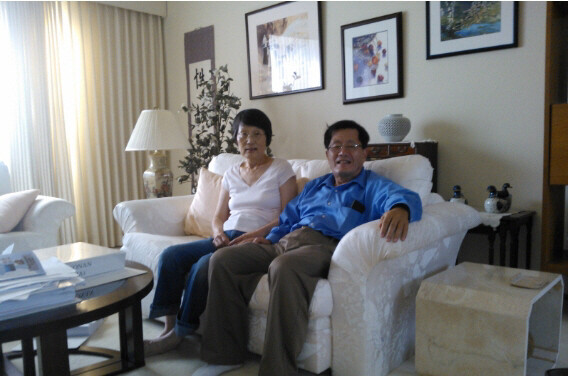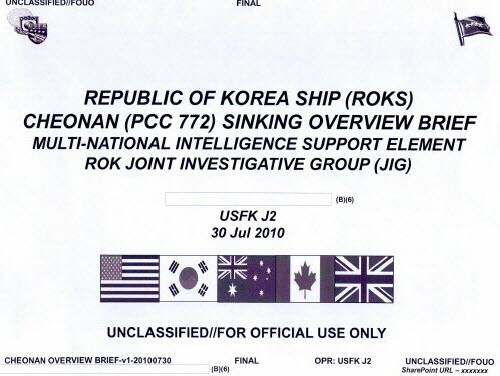hankyoreh
Links to other country sites 다른 나라 사이트 링크
[Interview] One old man’s arduous attempt to find the truth about the Cheonan

“If I don’t make an effort to reveal the truth about the Cheonan, I’ll hate myself.”
This is what Ahn Soo-myong, also known as Sam Ahn, 72, a scientist residing in the US, was thinking when he made his vow in 2011. In the field of antisubmarine warfare, Ahn is a preeminent expert, not only in the US, but worldwide.
When Ahn explains why he made his resolution, he always shares a story from around that time.
“I discussed the topic with engineers I had worked with, talented and dependable people. It was early 2011. Is the Joint Civilian-Military Investigation Group (JIG) telling us the truth in its report about the Cheonan? All of them agreed that it wasn’t.”
From that time, Ahn became obsessed with everything related to the sinking of the Cheonan warship: the people involved, the documents released, the comments made, the articles printed, and the academic papers published.
After meeting people, scrutinizing evidence, reading papers, asking questions, and digging as deep as he could, he finally reached the following conclusion: the JIG report was both unscientific and unscrupulous.

In Feb. 2012, Ahn published a booklet containing his doubts and his findings. It was titled, “Did a North Korean Submarine Sink the South Korean Cheonan?” The booklet can also be downloaded as an e-book from ahnpub.com.
Ahn says that he has taken a step that will enrage the South Korean government and JIG. After three years of hard work and lawsuits, he at last got his hands on around two thousand pages of documentation about the Cheonan sinking, by way of the American Freedom of Information Act.
Ahn has published the information, along with his own 100-page report, titled “Truth and Lies about the Cheonan,” which summarizes the information, online.
The report will soon become available for download from ahntech.com, the website of Ahn’s company. Ahn is charging money for the report, though, with a monthly access fee around 15,000 won (US$14).
According to Ahn, he had to pay the US navy more than US$900 for the documents - not to mention the approximately US$1 million he spent in legal fees over the past three years.
Paying for the report could be seen as a courteous gesture, but Ahn says in all seriousness that he wants to make some money from this.
Indeed, fresh doubts about the Cheonan sinking raised by news websites such as Newstapa and Voice of the People at the end of last year were based on the material that Ahn acquired from the US Navy. The documents are primary sources that are indispensable for getting to the bottom of the incident.
Also of interest is an autobiographical essay that Ahn had originally included in “Truth and Lies about the Cheonan”, but is now available separately. The essay describes the unusual life that Ahn has lived so far.
One of the memorable stories in the essay is how he was hustled into the basement of the Korean Central Intelligence Agency for writing an article critical of Major General Park Chung-hee’s May 16 coup while he was editor of Bulam Mountain, a newspaper at the engineering faculty at Seoul National University that he was attending in the early 1960s.
In the essay, Ahn also describes how his parents, who were Jehovah’s Witnesses, forced him to join the band while he was in high school, and about his love life while he was studying in the US.
There are quite a few reasons why Ahn regards the JIG report as unscientific. The primary one is that JIG concluded that a North Korean Yono-class midget submarine sank the Cheonan, but nowhere in the report can any grounds or evidence be found for how that could be possible.
Furthermore, Ahn thinks it was “unscrupulous” for JIG to draw the broad conclusion that the Cheonan was sunk by North Korea - a conclusion sure to provoke hatred for the North - without providing any kind of scientific grounds for this claim.
At this point, an American engineer had a question for Ahn. He asked Ahn if he was trying to prove his suspicions that JIG was provoking groundless hatred for people of the same nation, that is, North Koreans.
That’s right, Ahn told him. That’s exactly what I’m trying to do.
Ahn was fully aware of the utility of the US Freedom of Information Act. “According to the Freedom of Information Act, there is no need for me to explain why I want the information in question. In fact, if the US government doesn’t want to release information, it has to explain its reason to me,” he said.
But no matter how fine a law may be in theory, things work out differently in practice.
The documents that Ahn asked the US naval authorities to provide in June 2011 span nearly all of the activities of the US team of investigators led by Rear Admiral Thomas Eccles. The naval department in charge didn’t respond until nearly one year later, when it only provided him with 30 pages of material.

Ahn received a report by Rear Admiral Eccles in early May 2012 and a report by JIG‘s US-led international information support team on June 11. After that, he heard nothing more from the Navy.
It would take a long time to tell everything that happened during this period, events that make Ahn want to both laugh and cry. But to make a long story short, he expressed official complaints twice and filed a lawsuit. In the document he submitted to the court, Ahn relates, he wrote, “I’m 70 years old, and I suppose the US navy is hoping I will die.”
Fortunately - and appropriately - the court sided with Ahn, ordering the US Navy to respond to him by Aug. 2014. In late September of last year, well over a month after the court‘s deadline, the Navy finally sent Ahn files and discs containing 2,000 pages of material about the Cheonan.
But Ahn had to endure a great deal of grief along the way. When he tried to visit South Korea in early Sept. 2013, he was refused entry upon arrival at Incheon International Airport. It turned out that the South Korean government had classified him as an “unwelcome individual.”
And then, when he arrived at Los Angeles Airport on the way to his home in San Diego, he was detained for several hours by US government agents, who confiscated his mobile phone, files, and his laptop computer.
“I presume the American government was responding to a request for assistance from Nam Jae-joon, director the South Korean National Intelligence Service (NIS) at the time,” Ahn said.
Even during the administration of former president Lee Myung-bak (2008-2013), Ahn had freely visited South Korea. Entry to the country was denied the first time he tried to visit after President Park Geun-hye came to power.
Since that time, Ahn’s company, Ahntech, has been unable to win any contracts from the US government. Ahn filed a lawsuit, but he had to resign his position as president of the company and hand it over to someone else.
In regard to all these experiences, Ahn said, “I guess it’s only natural that an old man like me should pay this price for the Korean people, who have suffered so much”.
By Kang Tae-ho, senior staff writer
Please direct questions or comments to [english@hani.co.kr]

Editorial・opinion
![[Column] Is Korean democracy really regressing? [Column] Is Korean democracy really regressing?](https://flexible.img.hani.co.kr/flexible/normal/500/300/imgdb/original/2024/0705/2917201664129137.jpg) [Column] Is Korean democracy really regressing?
[Column] Is Korean democracy really regressing?![[Column] How tragedy pervades weak links in Korean labor [Column] How tragedy pervades weak links in Korean labor](https://flexible.img.hani.co.kr/flexible/normal/500/300/imgdb/original/2024/0703/8717199957128458.jpg) [Column] How tragedy pervades weak links in Korean labor
[Column] How tragedy pervades weak links in Korean labor- [Column] How opposing war became a far-right policy
- [Editorial] Korea needs to adjust diplomatic course in preparation for a Trump comeback
- [Editorial] Silence won’t save Yoon
- [Column] The miscalculations that started the Korean War mustn’t be repeated
- [Correspondent’s column] China-Europe relations tested once more by EV war
- [Correspondent’s column] Who really created the new ‘axis of evil’?
- [Editorial] Exploiting foreign domestic workers won’t solve Korea’s birth rate problem
- [Column] Kim and Putin’s new world order
Most viewed articles
- 110 days of torture: Korean mental patient’s restraints only removed after death
- 2Months after outcry over “torture devices,” Justice Ministry proposes more restraints for immigratio
- 3Beleaguered economy could stymie Japan’s efforts to buoy the yen
- 4[Column] Is Korean democracy really regressing?
- 5Koreans are getting taller, but half of Korean men are now considered obese
- 6[Column] How tragedy pervades weak links in Korean labor
- 7Former bodyguard’s dark tale of marriage to Samsung royalty
- 8Real-life heroes of “A Taxi Driver” pass away without having reunited
- 9[Editorial] Exploiting foreign domestic workers won’t solve Korea’s birth rate problem
- 10Democrats ride wave of 1M signature petition for Yoon to be impeached